Architectural folly by the Bouroullecs lights up the Rennes riverfront
Designed for the French city's waterfront, Le Belvédère is the latest example of Ronan and Erwan Bouroullec's extensive experimentation on them theme of urban landscaping, featuring their distinctive aesthetic simplicity in a new experiential form
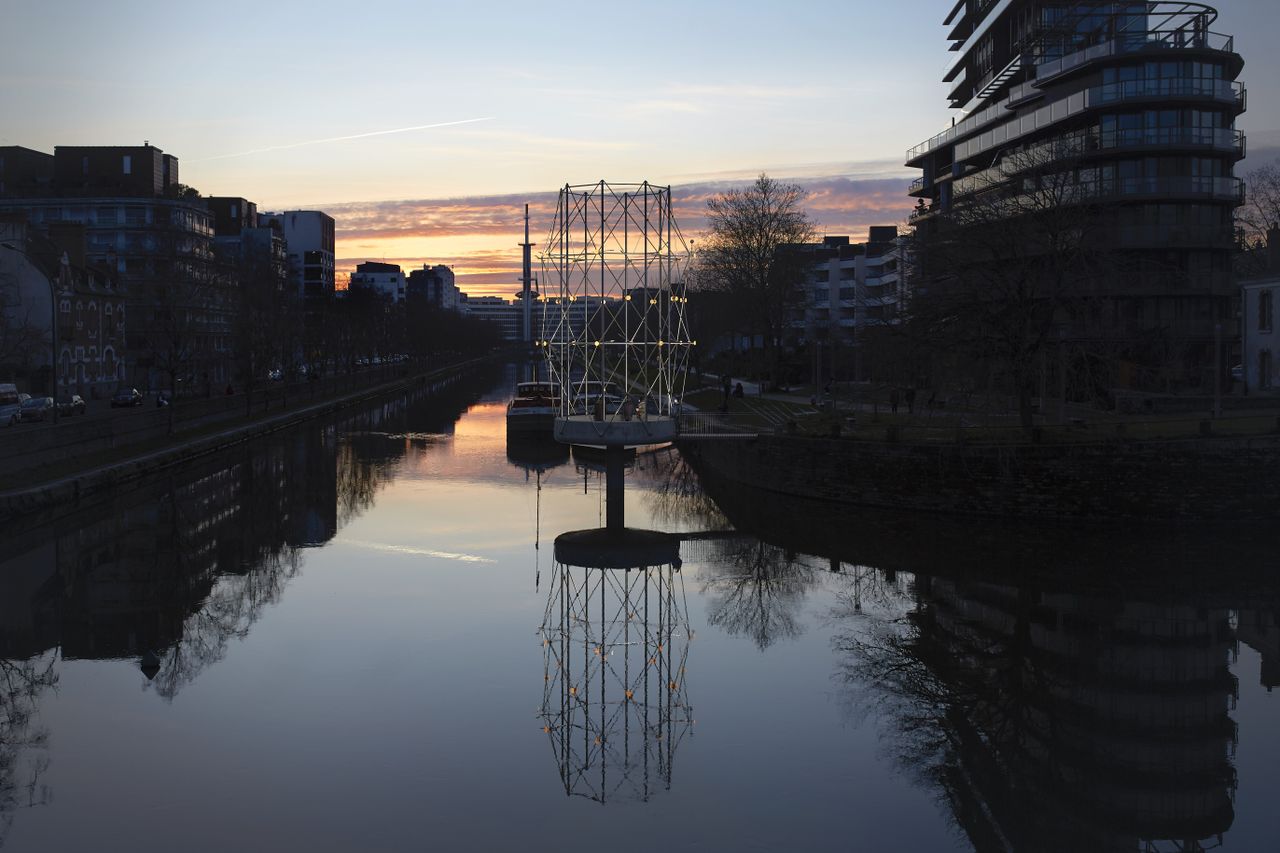
The latest design by Ronan and Erwan Bouroullec is a new pavilion for the city of Rennes, which the pair describe as ‘a symphony in space that evolves with its surroundings’.
The project’s origins date back to 2016, when the designers staged an exhibition across three venues in the French city including objects, micro-architecture and public installations. Part of the exhibition was a series of ‘Rêveries Urbaines’ (Urban Reveries), a speculative design exercise that offered ideas for the development of public space, featuring a mix of urban landscaping, green areas and experiential design proposals. ‘[It was] an exhibition that was the result of research around how we could contribute to a city – not particularly thinking of Rennes, but rather cities in general,’ says Ronan Bouroullec.
After three years of discussions and development based on the Urban Reveries’ principles, Le Belvédère has now become a permanent large-scale fixture on the Rennes’ riverfront, with a design referencing 18th century follies, ‘little buildings that served no specific purpose other than to satisfy a fancy.’
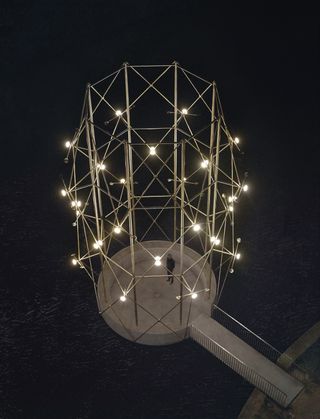
A night view of the Belvédère, featuring 32 luminous orbs that transform the pavilion into a lighthouse. Photography by Yann Peucat
The design is defined by the Bouroullec’s distinctive formal simplicity, a discreet presence in the town featuring a ‘corolla’ (a base made of a decorative material specially developed for the project, incorporating finely granulated brass elements into coloured concrete) supporting polished stainless steel masts and an intricate lattice design made of slender bars in polished, anodised aluminium. The structure, the designers explain, is also equipped with ‘16 little windmills and 32 luminous orbs that, at night, transform the Belvedere into a lighthouse.’
The delicate design is a practically beautiful solution to the main design challenge faced by the duo: to create an urban object whose presence wouldn’t obscure the views of the city. And in this case, the location was important and carefully considered as part of the design process, with the pavilion positioned on the river, aligned with the trees along with the Quai Saint Cyr. ‘We spent a lot of time walking around the city to identify the right position, the right site,’ continues Ronan Bouroullec. ‘While there are numerous interesting positions in Rennes, the clear choice, in the Vilaine, gives a particular view of the Cathedral, the old town, and of the emblematic modern and contemporary buildings of Rennes: Louis Arretche’s Mabilais, Georges Maillols’ Horizons, as well as more recent residential projects by Jean Nouvel and Christian Hauvette. The proximity of the Mail François-Mitterand, which is a popular new amenity for the people of Rennes, also struck us as important.’
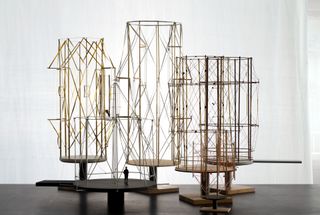
An example of Ronan and Erwan Bouroullec's ‘Rêveries Urbaines’ models from 2016, the project that inspired their pavilion design for Rennes. Photography courtesy of Studio Bouroullec
Standing at 13 m high above the river, the Belvédère is placed in conversation with the elements and the changing of the seasons, moving with the wind and serving different purposes at different times of the year. ‘Fine and virtually transparent, the Belvédère exists without existing,’ continues the designer. ‘It is a significant element that for reasons of symbolism and because of its position in the city, restores interest in an object that is freely open to any use one cares to name: a lighthouse and a landmark in the city, a place for new encounters and a meeting point, a place of contemplation.’
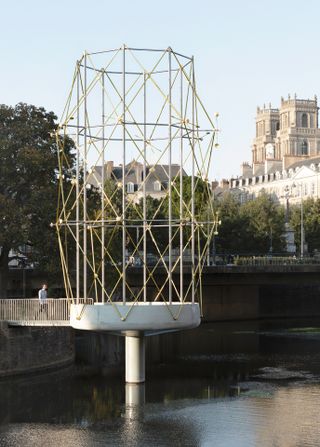
A view of the Belvédère by day. The structure features a 'corolla' made of a special mix of finely granulated brass elements and coloured concrete, and a structure featuring polished stainless steel masts and an intricate lattice design made of slender bars in polished, anodised aluminium. Photography courtesy of Studio Bouroullec
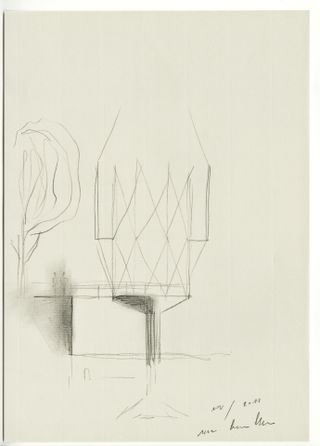
An early sketch depicting the designers' ideas for the folly. Courtesy of Studio Bouroullec
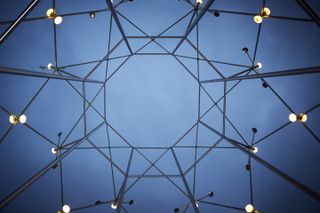
A view of the lattice structure from the platform. Photography: Yann Peucat
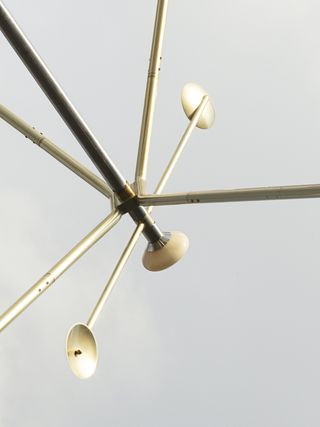
A detail of the pavilion's structure, featuring stainless steel and polished, anodised aluminium. Photography courtesy of Studio Bouroullec
INFORMATION
Wallpaper* Newsletter
Receive our daily digest of inspiration, escapism and design stories from around the world direct to your inbox.
Rosa Bertoli was born in Udine, Italy, and now lives in London. Since 2014, she has been the Design Editor of Wallpaper*, where she oversees design content for the print and online editions, as well as special editorial projects. Through her role at Wallpaper*, she has written extensively about all areas of design. Rosa has been speaker and moderator for various design talks and conferences including London Craft Week, Maison & Objet, The Italian Cultural Institute (London), Clippings, Zaha Hadid Design, Kartell and Frieze Art Fair. Rosa has been on judging panels for the Chart Architecture Award, the Dutch Design Awards and the DesignGuild Marks. She has written for numerous English and Italian language publications, and worked as a content and communication consultant for fashion and design brands.
-
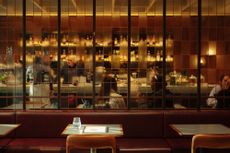 Fluid workspaces: is the era of prescriptive office design over?
Fluid workspaces: is the era of prescriptive office design over?We discuss evolving workspaces and track the shape-shifting interiors of the 21st century. If options are what we’re after in office design, it looks like we’ve got them
By Ellie Stathaki Published
-
 This collection of slow furniture is a powerful ode to time
This collection of slow furniture is a powerful ode to timeA serene exhibition of David Dolcini's 'Time-made' collection has fast-tracked its place into our hearts and homes
By Ifeoluwa Adedeji Published
-
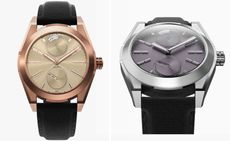 Is the Pragma P1 the most sustainable watch yet?
Is the Pragma P1 the most sustainable watch yet?Geneva-based brand Pragma combines industrial design with real sustainable credentials
By Hannah Silver Published
-
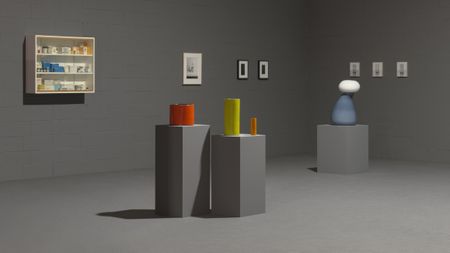 Ceramics brand Mutina stages a poetic tribute to everyday objects
Ceramics brand Mutina stages a poetic tribute to everyday objectsDesign meets art as a new Mutina exhibition in Italy reframes the beauty of domestic stillness, juxtaposing ceramics, sculpture, paintings and photography
By Laura May Todd Published
-
 Casa Mutina displays Ronan Bouroullec's creative universe
Casa Mutina displays Ronan Bouroullec's creative universeRonan Bouroullec's designs for Mutina at Milan Design Week 2024 include outdoor tiles as well as ceramic editions
By Cristina Kiran Piotti Published
-
 Ronan Bouroullec exhibition at Centre Pompidou features ceramics and amorphous ink drawings
Ronan Bouroullec exhibition at Centre Pompidou features ceramics and amorphous ink drawingsCentre Pompidou hosts Ronan Bouroullec's decorative designs, reflecting the designer's ongoing explorations of form and function (until 23 September 2024)
By Amy Verner Published
-
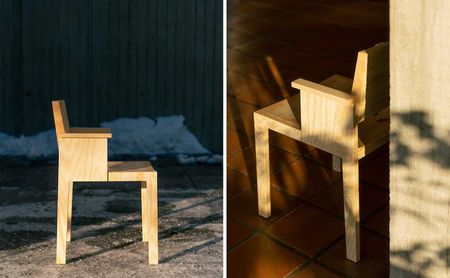 Vaarnii launches the ‘Maasto’ chair by Ronan Bouroullec
Vaarnii launches the ‘Maasto’ chair by Ronan BouroullecThe new Ronan Bouroullec chair for Vaarnii launches during Stockholm Design Week 2024, marking the Finnish company’s first experiments in pine plywood
By Rosa Bertoli Published
-
 Ronan Bouroullec’s new lamps with Manufacture de Sèvres resemble otherworldly creatures
Ronan Bouroullec’s new lamps with Manufacture de Sèvres resemble otherworldly creaturesManufacture de Sèvres presents Ronan Bouroullec’s ‘Lampes Sèvres’, an exhibition of new lighting works (until 25 November 2023)
By Rosa Bertoli Published
-
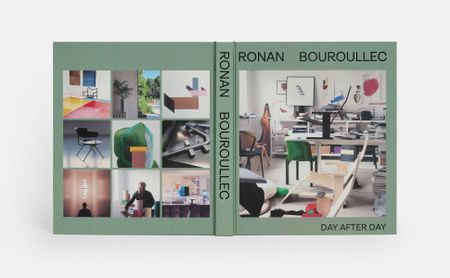 Ronan Bouroullec book merges art, design and everyday life
Ronan Bouroullec book merges art, design and everyday life‘Ronan Bouroullec: Day After Day’, from Phaidon, is a visual inventory of the French designer’s work, artistic output and daily inspiration
By Rosa Bertoli Published
-
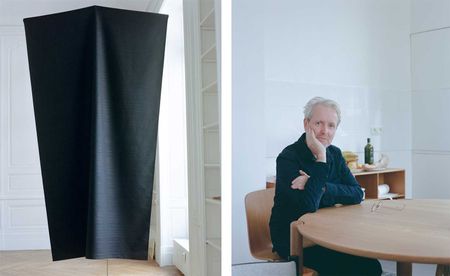 Ronan Bouroullec’s drawings become Kvadrat textiles
Ronan Bouroullec’s drawings become Kvadrat textilesDanish textile brand Kvadrat sees the power of Ronan Bouroullec's drawings, launching a new collection inspired by his sketches
By Amy Serafin Published
-
 Cassina Pro unveils new vision for office interiors at Orgatec
Cassina Pro unveils new vision for office interiors at OrgatecOrgatec 2022: Cassina takes part to the trade fair for office design and furniture deciphering the future of the workplace
By Martha Elliott Last updated